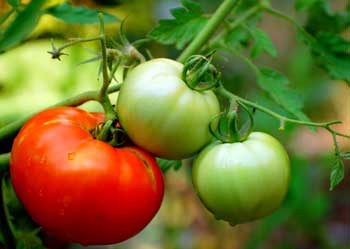Growing tomatoes in the garden
Learn more about our favorite vegetable/fruit, the tomato.
Tomatoes are one of the most popular of the garden vegetables. They are easy to grow, produce a lot of fruit and are rich in vitamins A, B and C. They can be used fresh or cooked, in salads or sauces, or can be frozen, dehydrated or canned. Tomato fruit can be red, pink, white, orange or yellow, depending on the variety. Most are round, but some are pear-shaped.
|
Tomato basic types
- All-purpose tomatoes – of medium size for a variety of uses.
- Early varieties – produce tomatoes in as little as 49 days from being transplanted.
- Cherry, grape, salad – small, tangy or sweet tomatoes that grow in clusters.
- Heirloom tomatoes – older tomato varieties with desirable characteristics.
- Paste tomatoes – used for making sauces or ketchup.
- Giant tomatoes – produce the largest tomatoes.
Tomato terms
Determinate varieties will grow to a certain size and all the fruit will ripen within a several-week period. They take up less garden space and usually don’t require staking. These tomatoes are ideal for large containers. Sometimes, they may be sold as “patio tomatoes.”
Indeterminate varieties continue to grow all season and produce fruit until frost. They should be caged or staked to keep fruit clean and prevent the fruit from being damaged when on the ground. These are the most common kind of tomatoes to find when buying transplants.
Disease resistance. Many tomato varieties will have V, F, N or T listed after the tomato name on the tag. This indicates resistance to Verticillium, Fusarium, Nematodes or Tobacco mosaic virus.
Start early
Tomatoes are a warm season crop and develop best when the temperatures are between 70 to 75°F. This is why many gardeners put in transplants the last week or two of May. Tomatoes take a long time to grow, so use transplants to give the tomatoes enough time to produce adequate fruit. Buy healthy transplants. It is possible to start tomatoes from seeds indoors about six to eight weeks before moving them outside. It is important to use fluorescent lighting to produce sturdy, compact, green plants. Buying transplants is easiest for many gardeners.
If you buy transplants
- Choose dark green, stocky plants 6 to 10 inches tall with stems the thickness of a pencil.
- Don’t buy tall, spindly plants or those with leaf spots, yellow or curling leaves. They are already experiencing difficulties.
- Avoid plants with flowers or fruit on them. They will not be big producers.
Once the plants have begun flowering and fruiting, they do not grow much more in size. Picking off flowers or fruit will not change the pattern of growth.
Transplanting
Tomatoes cannot withstand cold temperatures or cold soil. Transplant them after danger of frost has passed. Set plants 1 inch deeper than they were in containers. If tall and leggy, set deeper on a slant. Plant them in the evening or on a cloudy day.
Water well. A dilute starter fertilizer can be used, if desired. Cover plants at night if there are frost warnings. Remove the covers during the day.
Fun fact
Botanically, the tomato is a fruit. It is classified as such because the portion that is eaten contains reproductive structures (seeds). But in 1893, the tomato was declared a vegetable by the U.S. Supreme Court. The reason involved the collection of import duties. So, the tomato is either a fruit or a vegetable, depending if it is a botanical or legal definition.



 Print
Print Email
Email
